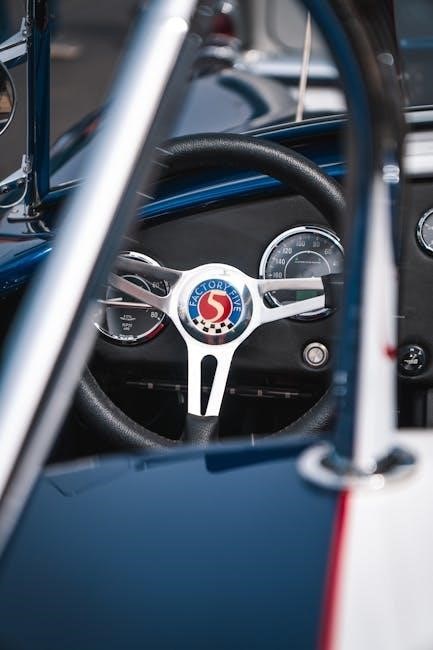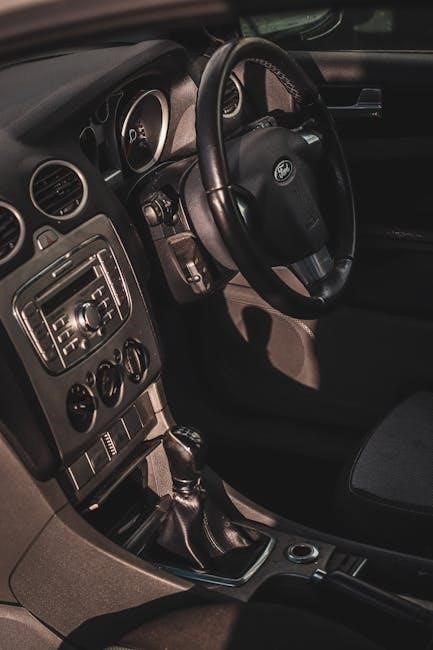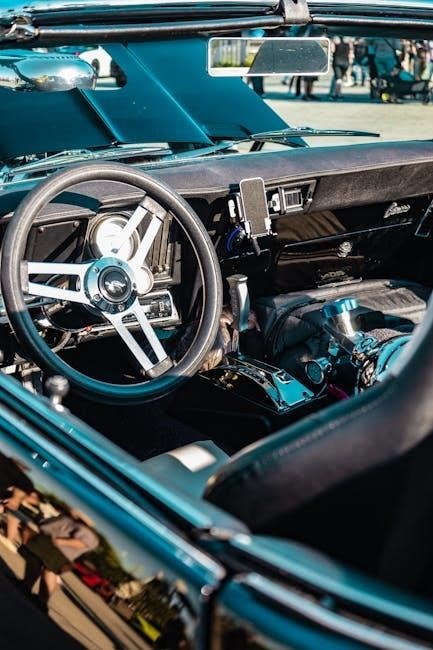Ford 3-Speed Manual Transmission Identification Guide
Welcome to the Ford 3-Speed Manual Transmission Identification Guide! This guide helps enthusiasts and mechanics identify and understand the unique features of Ford’s iconic 3-speed manual transmissions, including the popular 3.03 model and the revered Toploader. Learn about their history, design, and variations across Ford’s vehicle lineup.
Ford’s 3-speed manual transmissions are iconic components that have powered numerous classic and modern vehicles. These transmissions, including the well-known 3.03 model, were widely used in Ford trucks, cars, and even early Broncos. Designed for durability and simplicity, they feature a straightforward gear system with synchronized gears in later models. The 3-speed transmissions are easily identifiable by their compact size and unique tag system, which includes codes like RAT, RAN, or HEF, stamped on the transmission casing. These codes provide crucial information about the transmission’s specifications and applications. The 3.03 model, for instance, is named after the 3.03-inch distance between the countershaft and input shaft centerlines. These transmissions were often paired with Ford’s straight-six and small V8 engines, making them a staple in work trucks and performance vehicles alike. Their reliability and simplicity have made them favorites among enthusiasts for restorations and upgrades. This guide dives into the details of these transmissions, helping you identify, maintain, and enhance their performance.
Key Features and Components
Ford’s 3-speed manual transmissions are renowned for their robust design and essential components. A key feature is the synchronized gear system in later models, ensuring smoother shifting compared to earlier unsynchronized versions. The transmission case is typically cast with a 3-letter identification code, such as RAT or HEF, which helps in determining its application and specifications. The 3.03 model, for example, derives its name from the 3.03-inch distance between the countershaft and input shaft centerlines, a distinctive engineering feature. These transmissions often include a removable top cover, known as a “tin top,” which houses the gearshift mechanism and synchromesh components. The gear ratios are optimized for specific engines, such as the Ford 170 and 200 cubic-inch straight-six engines, ensuring efficient power delivery. Additionally, the transmissions are equipped with a planetary overdrive unit in some models, enhancing performance and fuel efficiency. These components make the Ford 3-speed manual transmissions both durable and versatile, suitable for a variety of vehicles from trucks to performance cars.
Visual Identification Methods
Visually identifying a Ford 3-speed manual transmission involves examining several key features. Start by locating the identification tag, typically found on the right side near the front where it bolts to the bellhousing. This tag often displays codes like RAT, RAN, or HEF, which are crucial for determining the transmission’s specific model and application.
Next, inspect the transmission’s top cover, known as the “tin top,” which is removable and houses the gearshift mechanism. The bolt pattern on this cover can help distinguish it from other transmissions, with the 3-speed usually having a specific arrangement. The gearshift itself is another identifying feature, as it protrudes directly from the top cover in most models.
Look for the 3-letter ID cast into the main transmission case, often located on the passenger side or near the front. This code, along with any casting numbers or part codes on the case, can be cross-referenced with Ford’s parts catalog or online databases for precise identification. Additionally, check for the presence of an overdrive unit, which may appear as a thicker section between the main case and tailshaft.
Consider the transmission’s size and application, as it was commonly paired with specific engines like the Ford 170 or 200 cubic-inch straight-six. The overall shape and mounting points can indicate its intended use. For differentiation from 4-speed models, note that the 3-speed typically has fewer bolts on the top cover, usually nine instead of ten. Finally, consulting a Ford transmission identification chart can provide clear visual references to confirm your findings.

Transmission Models and Applications
Ford produced several distinct 3-speed manual transmission models, each tailored for specific applications. The 3.03 model, for instance, was widely used in Ford trucks from 1964 to 1973 and was also employed in some four-speed applications due to its durability and versatility. This transmission earned its name from the 3.03-inch distance between the countershaft and input shaft centerlines, making it a favorite for both light-duty trucks and passenger vehicles.

The Toploader, another iconic 3-speed transmission, gained popularity for its robust design and ease of maintenance. It was commonly found in classic Ford vehicles like the Bronco, Mustang, and Fairlane, pairing seamlessly with both inline-six and V8 engines. The Toploader’s widespread use across various Ford models underscores its reliability and adaptability.
Additionally, Ford’s 3-speed transmissions were often paired with smaller engines, such as the 170 and 200 cubic-inch straight-six engines, making them ideal for lighter vehicles. The HEF model, for example, was specifically designed for certain Ford and Mercury applications, further highlighting the diversity of these transmissions. By understanding the specific models and their intended uses, enthusiasts can better appreciate the engineering behind Ford’s 3-speed manual transmissions.
Decoding Transmission Tags and Codes
Identifying a Ford 3-speed manual transmission often begins with decoding the transmission tag or code. These tags are typically located on the passenger side of the casing near the front or on the bellhousing. They contain essential information such as the transmission model, gear ratios, and application details. For example, codes like “RAT,” “RAN,” or “HEF” are commonly found and correspond to specific transmission models and years of production.
The transmission tag may also include a series of numbers and letters that denote the parts list, serial number, and gear ratios. For instance, the 3.03 transmission model is often marked with a tag that specifies its application in Ford trucks or passenger vehicles. By deciphering these codes, enthusiasts can determine whether the transmission is a Toploader, 3.03, or another variant, as well as its compatibility with specific engines and vehicles.
For accurate decoding, it’s recommended to consult Ford’s Master Parts Catalogs or contact a dealership for assistance. Understanding these codes is crucial for ensuring proper transmission identification and maintaining authenticity in restoration projects.
Gear Ratios and Performance
Ford 3-speed manual transmissions are known for their robust gear ratios, which vary depending on the specific model and application. The 3.03 transmission, for instance, features a 3.03:1 first gear ratio, making it ideal for heavy-duty applications like Ford trucks from 1964 to 1973. This ratio provides strong low-end torque, suitable for hauling and towing. In contrast, the 2.77:1 ratio, commonly found in six-cylinder engines, offers a balance between performance and fuel efficiency for lighter vehicles.
The Toploader transmission, a favorite among enthusiasts, is renowned for its durability and performance in both street and racing applications. Its gear ratios are optimized for a wide range of driving conditions, with a focus on smooth shifting and consistent power delivery. The 3-speed manual transmissions are also praised for their simplicity and reliability, making them a popular choice for vintage Ford restorations and upgrades.
Understanding the gear ratios is essential for maximizing the performance of these transmissions, whether in everyday driving or off-road adventures. The combination of sturdy construction and well-engineered ratios ensures that Ford 3-speed manuals remain a cornerstone of classic automotive performance.
Maintenance and Common Issues
Regular maintenance is crucial to ensure the longevity and performance of Ford 3-speed manual transmissions. Owners should check the transmission oil level periodically, as low oil levels can lead to premature wear on bearings and gears. Leaks from the gasket or seal are common issues and should be addressed promptly to prevent fluid loss. Additionally, unusual noises, such as grinding or whining, may indicate worn bearings or misaligned gears, requiring immediate inspection.
One of the most common problems with these transmissions is synchronizer wear, which can cause difficulty shifting gears. Replacing worn synchronizers or bearings is often necessary to restore smooth operation. Another issue is the input shaft seal wear, which can lead to oil leakage. Proper adjustment of the clutch linkage and regular lubrication of moving parts can prevent many of these problems. Despite their durability, Ford 3-speed transmissions benefit from routine servicing to maintain their reliability and performance over time.
Parts Sourcing and Suppliers
When maintaining or restoring a Ford 3-speed manual transmission, sourcing the right parts is essential. Fortunately, these transmissions are well-supported by both aftermarket suppliers and enthusiasts. Companies like Summit Racing, RockAuto, and eBay Motors offer a wide range of replacement parts, including bearings, seals, gaskets, and synchronizers. Specialty shops, such as Toploader Transmissions, focus specifically on Ford 3-speeds and provide hard-to-find components like the iconic “tin top” cover.
For those on a budget, salvage yards and classic car forums can be valuable resources for used or refurbished parts. Additionally, many transmission rebuild kits are available, which include all the necessary components for a complete overhaul. Always ensure that parts are compatible with your specific transmission model, as variations exist across different Ford applications. Consulting with knowledgeable suppliers or transmission specialists can help you find the right parts for your project.
Online communities and forums dedicated to Ford transmissions are also great sources for advice and parts recommendations. With the right suppliers and resources, keeping your Ford 3-speed manual transmission in top condition is achievable and cost-effective.
Modifications and Upgrades
Upgrading or modifying a Ford 3-speed manual transmission can enhance its performance and adapt it to modern driving demands. One popular modification is swapping to a T-5 five-speed manual transmission, offering better gear ratios for both acceleration and highway cruising. This swap is particularly common in classic Ford restorations and hot rods.

Another upgrade involves adding an overdrive unit, which can improve fuel efficiency and reduce engine strain at higher speeds. Enthusiasts often opt for the Ford 31 Overdrive or similar aftermarket solutions. Additionally, installing a modern clutch kit or lightweight flywheel can enhance drivability and responsiveness.
For those seeking a more contemporary feel, the MT88 seven-speed manual transmission, used in some Ford models, provides a wider range of gears and smoother shifting. However, such swaps require careful planning and compatibility checks. For parts and expertise, enthusiasts can turn to trusted suppliers like Summit Racing, RockAuto, or specialty shops like Toploader Transmissions.
Upgrades should always align with the vehicle’s intended use, whether for daily driving, racing, or off-road adventures. Proper installation and tuning are crucial to ensure optimal performance and longevity of the transmission.

For further guidance, explore resources like MustangForums.com, SummitRacing.com, and Ford Truck Master Parts Catalogs. These sources offer detailed identification charts, repair tips, and parts suppliers. Additionally, communities like ConcoursMustang and SAAC provide invaluable insights and support for transmission projects.
Always consult original shop manuals or contact Ford dealerships for precise information on specific models. With the right tools and knowledge, you can keep these legendary transmissions running smoothly for years to come.